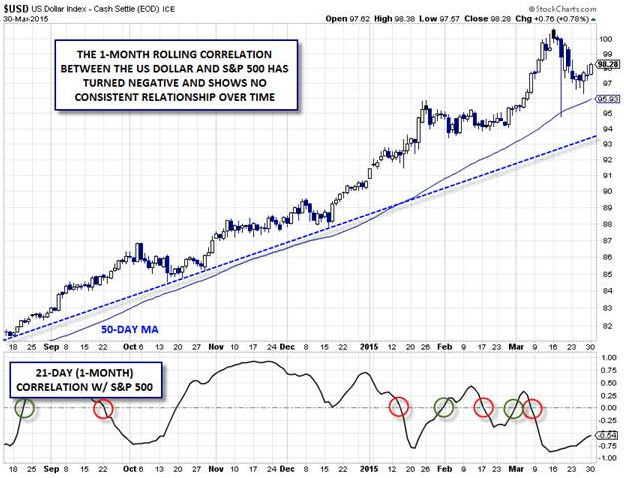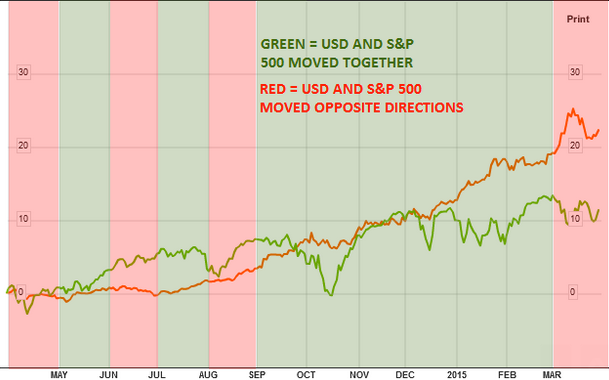“There’s no place like home. There’s no place like home. There’s no place like home.”
- Dorothy, “The Wizard of Oz”
At the deus ex machina conclusion of the 1939 movie The Wizard of Oz, the protagonist Dorothy learns that her magical silver shoes will take her wherever she wants to go as long as she repeats her destination three times.
In many regards, it seems like some traders think they have their own version of magical shoes: as long as they repeat a mantra enough times, it will become true. One dubious trading theory that is currently seeing its day in the sun is that the U.S. dollar and U.S. stocks move together, or in other words, that they are positively correlated. After all, both the US dollar index and S&P 500 have rallied in each of the last five months as the U.S. has become the proverbial “best house” in bad global economic “neighborhood.”
Interestingly, the recent positive correlation actually runs against the Economics 101 textbooks, which will tell you that a strong dollar will hurt the overseas earnings of large multinational companies, leading to weakness in those stocks. Perhaps the growing chorus of companies blaming the strong dollar for their weak profits, along with the Fed’s downward revision to growth estimates, has reminded traders of this effect, with stocks on track to close lower amidst further dollar strength this month.
But even this inverse correlation has little relationship to actual markets.
Looking at the actual data, the U.S. Dollar and U.S. equities do not have a consistent relationship whatsoever. The 21-day (1-month) correlation coefficient, which mathematically measures the extent to which two data series move together, is currently -0.54; this means that over the last month, U.S. stocks have tended to fall when the dollar rises. That said, the 1-month correlation was actually positive at the start of March (indicating that the dollar and S&P 500 were moving in the same direction). More to the point, the 1-month correlation has “flipped” from positive to negative five times already this year, showing no consistent relationship between the USD and US equities. The 6-month rolling correlation (not shown) has also flipped from mostly negative in 2012 to positive in the middle of 2013, then back to negative until midway through last year, and it’s now showing a positive relationship once again.

Source: Stockcharts.com,FOREX.com
For the more visual readers, the below overlay chart of the S&P 500 and US dollar index shows similar monthly directional movements (up or down) highlighted in green and opposite monthly directional movements highlighted in red:

Source: Bloomberg, FOREX.com
So what is the upshot of this analysis? Many traders and analysts (logically) argue that the recent strength in the US dollar will hurt stock market performance moving forward, and to some extent, it probably will provide a headwind. But even if the dollar continues to trend higher, the ever-changing correlation between the US dollar and stocks suggests that the S&P 500 could also strengthen further. Conversely, even if the US economy continues to perform strongly, it doesn’t necessarily mean that either the dollar or S&P 500 will necessarily strengthen in lockstep.
Unlike Dorothy, we all live and trade in the real world, so it’s worthwhile to analyze the actual data and come up with a plan of action, rather than rely on a wish and a pair of magic shoes.
For more intraday analysis and market updates, follow us on twitter (@MWellerFX and @FOREXcom)
